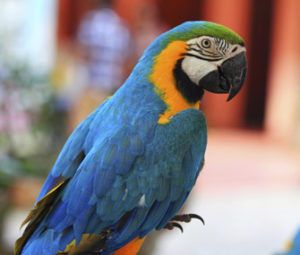
The following article was written by Laurie Hess, DVM, DABVP (Avian Practice)
Dr. Laurie Hess is one of approximately 150 bird specialists in the world board-certified by the American Board of Veterinary Practitioners.
Thanks to various public service campaigns, we are all aware of the thousands of unwanted dogs and cats in the U. S. who are desperate for forever homes. But would it surprise you to know that the same is true of parrots? January is Adopt a Rescued Bird Month, which is a perfect time to learn more about being a good bird owner — and about how you can help abandoned birds find new homes.
Why Do Parrots End Up in Shelters?
According to the Avian Welfare Coalition, fewer than 100 parrot rescue organizations unaffiliated with breeding facilities exist nationwide, versus thousands of shelters that take in dogs and cats. Few public shelters have facilities to house or care for unwanted parrots, and many shelters are forced to turn birds away. Consequently, many parrots are euthanized because there is nowhere to place them.
Why do so many parrots end up unwanted? While there are certainly many reasons, here are what I consider the top five.
Potential parrot owners purchase birds on a whim. Too many people see colorful, playful parrots in pet store windows and rush to buy them, without any knowledge of what owning a parrot entails. Or their children want a pet, and they get a bird because it doesn’t take up much space or need to be walked. Unfortunately, these impulse buyers get the bird home and discover that it’s very messy, tossing food all over its cage and on the floor, and that it actually needs time out of the cage every day (the equivalent of a dog’s walk). Many birds also develop behavior problems, such as screaming for attention.
Many parrot owners are unfamiliar with normal bird behavior. In the wild, birds comunicate by screaming, particularly during feeding, which takes place at dawn and dusk. But dawn and dusk are not ideal times to have a screaming pet in the house. In their attempts to put a stop to the noise, pet owners will often inadvertently reinforce the screaming behavior by running to the bird’s cage and giving it attention, even if it is only to reprimand it. In addition, birds normally use their beaks as appendages to help them climb around and as tools to help them eat. People mistakenly assume that a bird who reaches out with its beak is trying to bite them, so they will label it as aggressive or mean. Finally, many people expect young birds to be like puppies with wings, when in fact birds are extremely independent and may not always be as submissive as many dogs.
Parrot owners don’t understand their bird’s social needs. Birds are very social creatures; wild parrots live in flocks numbering hundreds to thousands. Many pet parrots have not been raised with other birds and will look on their human caretakers as flock-mates. This relationship may work just fine until a parrot reaches sexual maturity (for many medium- to large-size parrots, around 5–8 years of age) when it may begin to see one of its beloved human flock-mates as a sexual partner. The bird may then become very protective of that individual, attacking other people in the house who interact with the love object, or the bird may start to scream or pick at its own feathers and skin out of sexual frustration. Many parrots are given up to shelters when they reach sexual maturity because they’ve developed behavior problems like these.
Parrot owners don’t plan for veterinary care. Beyond the cost of the purchase, many bird owners never consider the expenses associated with owning a bird. Unlike most dog and cat owners, who are aware that their pets will need to go to the vet for vaccinations, deworming, training, etc., bird owners almost never set aside funds for veterinary care. In fact, many bird owners fail to to provide preventive medical care for their pet and are surprised when their pet gets sick and requires emergency veterinary treatment.

Leave a Reply